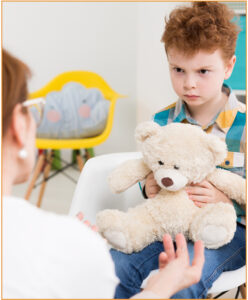 Applied Behaviour Analysis (ABA) is the science of changing environments so that an individual and their family can have a better life. ABA is most commonly known as an evidence-based treatment for individuals with Autism Spectrum Disorders (ASDs), but its efficacy certainly does not end there. ABA can be used to teach many skills, such as communication and learning, and can also be used to decrease minor to severe challenging behaviours (such as tantrums, aggression, and self-injury). ABA can be a controversial treatment choice (see Durling 2021), referred to as “robotic”; however, effective treatment and nurturing treatment are not mutually exclusive – with the right practitioner, a balance can be struck.
Applied Behaviour Analysis (ABA) is the science of changing environments so that an individual and their family can have a better life. ABA is most commonly known as an evidence-based treatment for individuals with Autism Spectrum Disorders (ASDs), but its efficacy certainly does not end there. ABA can be used to teach many skills, such as communication and learning, and can also be used to decrease minor to severe challenging behaviours (such as tantrums, aggression, and self-injury). ABA can be a controversial treatment choice (see Durling 2021), referred to as “robotic”; however, effective treatment and nurturing treatment are not mutually exclusive – with the right practitioner, a balance can be struck.
People are very resourceful at getting their needs met, even if that means engaging in behaviours that are “problematic” for the rest of us. The challenge is that the rest of the world does not necessarily consider that same approach as “appropriate” or “socially acceptable”. The problem behaviours have been “working” for the individual (i.e., they’ve been able to get what they want or get rid of the thing they don’t want). It’s important that care is taken to meet those needs but in safe and acceptable ways.
Currently, Ontario provides funding for ABA services for children and adolescents through the Ontario Autism Program (OAP). To fund hours under this program, a Board Certified Behavior Analyst (BCBA) provides clinical
supervision of ABA assessment and treatment. As a specialized position, a BCBA requires a master’s degree, exam, and 3000 clinical hours post certification. As a BCBA, I am currently a registered service provider with
the OAP and am now accepting funded and fee-for-service clients, with or without an ASD diagnosis. I frequently consult with other disciplines such as social work, psychology, psychiatry, occupational therapy (like this occupational therapy near me), speech and language pathology, and physical therapy. For complex cases, our clinic also provides consultations with a Board Certified Behavior Analyst – Doctoral (BCBA-D).
There are many approaches to managing difficult behaviors, but as a BCBA, I look less at the symptoms of the challenging behavior and more at the causes because the same behavior may happen for a variety of reasons. For example, someone might bang their head because they have a headache, but headbanging could also happen because the individual wants a caregiver’s attention when they are busy on the phone.
The reason the behavior is happening is what BCBA’s call the function. While not a perfect system, many BCBAs categorize the function of behavior four ways:
1) attention, 2) tangible, 3) escape/avoidance and 4) sensory/automatic.
Figuring out the function of a behavior is critical to provide effective treatment and should be done under the supervision of a BCBA. Once the function of a behavior is determined, an individualized treatment plan is developed based on the unique variables present in the environment. Through ABA, alternative behaviours can be learned to access the same consequence in a more acceptable manner. A behaviour plan can improve the health and functioning of the person, prevent the problem behaviour, teach an alternative behaviour, and reinforce more desirable behaviours. Here are some quick tips when applied based on the function of behaviour.
1) Attention functions allow the person to get a positive or negative social interaction, reaction, or response. For example, “Oh no! Tommy, you spilled your food again?! What a huge mess! Now we must clean it up.” Instead, you could try ignoring the mess and continuing with mealtime conversation, waiting for a moment when Tommy is doing anything that you would like to see at the table (e.g., sitting, chewing) and give positive attention. For example, “Tommy – you’re eating so much food, you must be so hungry!” Sometimes, this planned ignoring approach is not safe because the behaviour may be more dangerous (e.g., physical aggression). In this case, it could be helpful to use non-contingent reinforcement. This is a fancy way of saying, provide lots of attention whether the challenging behaviour is happening or not. It may also help to have some preventative measures in place (e.g., no projectiles in the vicinity).
2) Tangible is another way of saying “get.” The person gets something – a thing or an activity that they really like such as their favourite frozen snack, or a funny YouTube video, or to swing by themselves. For example, a non-vocal boy is hungry and pulls his mom’s hair to get her to make him a snack. A possible replacement behaviour could be passing a snack picture to mom to communicate “I’m hungry.” Another way to provide fun items or activities is to make the tangible contingent upon a task. For example, “First brush your teeth. Then watch a music video.”
3) Escape/avoidance has to do with delaying an impending task (e.g., procrastinating paying bills) or stopping an unpleasant task or activity altogether (e.g., splashing to end bath time). Providing a choice of options is a powerful prevention strategy that puts the individual in charge. For example, offering which chore to complete first or in what order could be effective. Alternatively, you can make the task more enjoyable or check whether your expectations are realistic. If the task is just too difficult, the individual might need to be taught some new skills. Visual schedules or warning that the fun activity will end soon can also help transition away from a preferred activity (e.g., leaving the park). For more severe cases of aggression, removing all demands for a certain amount of time and then slowly building back to typical instructions has been shown to prevent and reduce problem behaviour.
4) Sensory/automatic has to do with body needs that cause an individual to seek out “feel good” experiences or behaviours. This could look like humming, spinning in a chair, or squinting eyes and looking through eyelashes. Typically, sensory functions can be the most difficult to treat. However, much evidence shows that behaviours with sensory functions can still be managed. For example, replace hairpulling with pulling strings from a “puffer-ball-toy” to simulate the same feeling. Running away could happen because the lights are too bright or the sounds are too loud, in which case sunglasses or headphones could dull the sensory input.
As a BCBA, I encounter quite a range of challenging behaviours across many ages – young children to adults. Outcomes vary depending on the unique presentation of the person, but a qualified BCBA can partner with you to help find a better way to manage the chaos.
Disclaimer: these suggestions have been given based on generalities. If you have a behaviour of concern, please contact a BCBA in your area to get support in implementing an individualized treatment.
A list of references for this article can be found at the online version of this article at www.qxplore.com/fall-2022-references
Whitney Kerr, M.A., BCBA provides behavioural consultation services through the EAP; services for children and adolescents funded under the Ontario Autism Program or institutions or non-profit organizations; services for adults funded through non-profit organizations; and privately.

